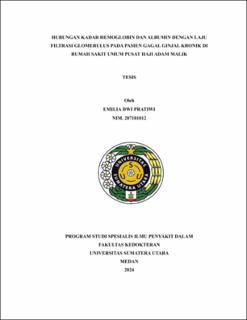Hubungan Kadar Hemoglobin dan Albumin dengan Laju Filtrasi Glomerulus pada Pasien Gagal Ginjal Kronik di Rumah Sakit Umum Pusat Haji Adam Malik
The Relationship of Hemoglobin and Albumin Levels with Glomerular Filtration Rate in Chronic Kidney Failure Patients at The Adam Malik Hajj Center General Hospital

Date
2024Author
Pratiwi, Emilia Dwi
Advisor(s)
Nasution, Alwi Thamrin
Nasution, Bayu Rusfandi
Metadata
Show full item recordAbstract
Introduction: Chronic Kidney Failure (CKD) is defined as a condition of kidney damage that occurs continuously for 3 months or more with an estimated glomerular filtration rate (eGFR) of less than 60 ml/minute/1.73 m2. In theory, Na-Cl levels are related to GFR. However, Na-Cl levels as a prognostic marker for worsening CKD have never been studied in prospective clinical trials aimed at CKD patients. A decrease in the difference in bicarbonate levels also indicates that there is worsening of CKD, the need for renal replacement therapy and limited compensation for acidosis by the body's buffer system. It is known that CKD patients with serum bicarbonate levels >22 mEq/L will experience a decrease in the progression of CKD. Data on serum bicarbonate levels was obtained through blood gas analysis. Research in Japan states that the difference in Na-Cl levels can be used as a marker of acidosis so that the difference in Na-Cl levels levels can replace AGDA in assessing worsening of GFR. In other words, the Na-Cl levels and HCO3 levels is considered to equally affect GFR. Method: The research was conducted at the RSUP Haji Adam Malik using medical record data from January 2022 to January 2023. The research design was observational analytic with a cross-sectional approach to prove the relationship between the difference in Na-Cl levels and HCO3 levels with the GFR in patients. CKD at the RSUP Haji Adam Malik. The sample for this study was 35, an accessible population that met the inclusion criteria and exclusion criteria using Spearman analysis to assess correlation variables. Results: This study followed 35 patients with CKD in the emergency department, inpatient unit, and nefrologist clinic at RSUP Haji Adam Malik. The largest number of subjects was 22 male (62.9%). The average age of the subjects was 60.14 years with the youngest being 29 years old and the oldest being 75 years old. The most common comorbidity was type 2 DM with 25 people (71.4%), followed by hypertension with 19 people (54.3%) and hyperuricemia with 10 people (28.6%). Using the Spearman correlation test, it showed that there was no significant relationship between the Na-Cl levels and the difference in HCO3 on changes in GFR between the first and second examinations (p>0.05) in CKD patients treated at RSUP Haji Adam Malik. Conclusion: There was no significant relationship found between hemoglobin and albumin levels with in GFR (p>0.05) in patients with CKD at RSUP Haji Adam Malik
Collections
- Master Theses [407]
